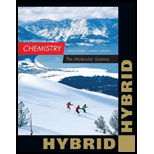
Concept explainers
Interpretation:
Binding energy per nucleon for the two isotopes of boron has to be calculated and their stability has to be compared.
Concept Introduction:
Binding energy is a short strong force that is present in the nucleus which holds the protons together by overcoming the electrostatic repulsive forces between them. Whenever there is a change in energy, a corresponding change in mass is also observed and this can be given by the equation shown below,
When more particles combine to form nuclear there is a great change in mass and energy. The nuclear stabilities can be compared more appropriately by dividing the binding energy of nucleus with the number of nucleons. The result obtained is the binding energy per nucleon. Protons and neutrons are known as nucleons. Binding energy is represented as
Explanation of Solution
Given equations in the problem statement is,
For
The change in mass can be calculated as shown below,
Nuclear binding energy can be calculated as shown below,
Binding energy per nucleon can be calculated as shown below,
There is a total of ten nucleons in boron-10. Hence, the binding energy per nucleon can be calculated as,
Binding energy per nucleon in
For
The change in mass can be calculated as shown below,
Nuclear binding energy can be calculated as shown below,
Binding energy per nucleon can be calculated as shown below,
There is a total of eleven nucleons in boron-11. Hence, the binding energy per nucleon can be calculated as,
Binding energy per nucleon in
On comparing the binding energy per nucleon for
Want to see more full solutions like this?
Chapter 18 Solutions
Chemistry: The Molecular Science, Hybrid Edition (with OWLv2 24-Months Printed Access Card)
 Chemistry: The Molecular ScienceChemistryISBN:9781285199047Author:John W. Moore, Conrad L. StanitskiPublisher:Cengage Learning
Chemistry: The Molecular ScienceChemistryISBN:9781285199047Author:John W. Moore, Conrad L. StanitskiPublisher:Cengage Learning Chemistry & Chemical ReactivityChemistryISBN:9781337399074Author:John C. Kotz, Paul M. Treichel, John Townsend, David TreichelPublisher:Cengage Learning
Chemistry & Chemical ReactivityChemistryISBN:9781337399074Author:John C. Kotz, Paul M. Treichel, John Townsend, David TreichelPublisher:Cengage Learning
 Chemistry: An Atoms First ApproachChemistryISBN:9781305079243Author:Steven S. Zumdahl, Susan A. ZumdahlPublisher:Cengage Learning
Chemistry: An Atoms First ApproachChemistryISBN:9781305079243Author:Steven S. Zumdahl, Susan A. ZumdahlPublisher:Cengage Learning ChemistryChemistryISBN:9781305957404Author:Steven S. Zumdahl, Susan A. Zumdahl, Donald J. DeCostePublisher:Cengage Learning
ChemistryChemistryISBN:9781305957404Author:Steven S. Zumdahl, Susan A. Zumdahl, Donald J. DeCostePublisher:Cengage Learning Chemistry: Principles and PracticeChemistryISBN:9780534420123Author:Daniel L. Reger, Scott R. Goode, David W. Ball, Edward MercerPublisher:Cengage Learning
Chemistry: Principles and PracticeChemistryISBN:9780534420123Author:Daniel L. Reger, Scott R. Goode, David W. Ball, Edward MercerPublisher:Cengage Learning





